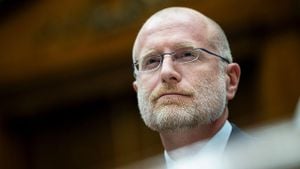RIO DE JANEIRO — President Biden missed the group photo opportunity with world leaders at the G20 summit on Monday, which raised eyebrows and sparked confusion among journalists present at the event. An unexpected moment unfolded when reporters noted the absence of the U.S. President, with one pool reporter humorously exclaiming, "Oh my God... they took it!" and pointing out, "Yup, he's right there ... he's behind the palm tree right now!"
This misstep came amid considerable speculation before the summit, with sources indicating Biden, 81, might forgo the photo op to avoid being seen alongside Russian Foreign Minister Sergey Lavrov. This decision was influenced by the tense backdrop of the Ukraine conflict. The White House later attributed Biden's absence to "logistical issues," asserting it was simply bad timing.
Despite the official explanation, skepticism lingered among political observers and news outlets, highlighted by the awkward image of Biden missing from the photograph where world leaders gathered cheerfully, clasping hands and flashing smiles. Joining him at the sidelines was the Canadian Prime Minister Justin Trudeau, who, like Biden, also narrowly missed out on the visual capturing of leaders.
The photo-taking was prompted earlier than scheduled, according to discussions among reporters and officials, which painted the administration's explanation as somewhat unsatisfactory. While Biden's team claimed they took the photo as per the timeline without fully waiting, it contrasted sharply with the arrangements witnessed during the predecessors' gatherings. "Due to logistical issues, they took the photo early before all the leaders arrived," stated a senior Biden administration official.
Interestingly, this incident echoes previous unfortunate optics for Biden on the global stage. Just days prior, at the APEC conference held in Lima, Peru, Biden found himself relegated to the back corner during the event's family photo. Chinese President Xi Jinping stood front and center, leading to accusations from various political figures who lambasted Biden as increasingly irrelevant on the world stage.
Political ranking and optics at such international gatherings have long swayed public perception. Historical precedent shows leaders like former President Donald Trump enjoyed prime positional advantages during APEC summits, with strategic placements at the forefront of images. Contrastingly, Biden was humorously dubbed the “super lame duck” by his critics, highlighting the perceived diminishing authority of his presidency.
While the rules for placement were explained as alphabetical, political commentators noted discrepancies. Previous APEC gatherings had seen leaders such as Biden being prioritized more favorably. The indignation around his placement drew comments from Republican lawmakers, who expressed dismay at Biden's apparent worldwide status erosion. "There are lame ducks and then there are the lamest of lame ducks," remarked Rep. Jeff Van Drew (R-New Jersey), encapsulating the feelings shared by many onlookers.
Meanwhile, the G20 summit proceeded with agenda items focused on pressing global issues, including talks surrounding hunger and poverty. Biden's absence from the photo came just as he had pledged $4 billion for developing nations during the G20 meeting, highlighting the stark reality of his role at the summit.
With expectations high for Biden's performance at his final G20 meeting as president, the globe watched closely, noting key appearances and interactions. The importance of strong visual representation as part of leadership effectiveness could not be understated as world leaders navigate not just domestic, but international challenges.
The dynamics of global leadership are clearly changing, as the younger generation of leaders begins to assert themselves upon the world stage. Attendees from other nations—like Australian Prime Minister Anthony Albanese and Canadian PM Trudeau—drew attention to the delicate interplay of diplomacy and positioning as they stood prominently during the event.
With Biden now bound for Brazil for his next engagements, the optics of his environmental commitment may yield additional significance. Scheduled for aerial tours of the Amazon rainforest and G20 discussions on climate change, this leg of Biden's visit may be pivotal. This new chapter might allow for more imagery meant to portray him alongside Brazil's leadership on environmental matters, currently under scrutiny as floods and deforestation press the agenda of global actions.
The recently concluded summit may pave the way for Biden to accentuate U.S. commitments to climate leadership, which has been challenged on many fronts domestically. Still, the backdrop of these international appearances weighs heavily under the scrutiny of prior missteps—missed photographs being just one thread tying together the narratives of his time on the world stage and showcasing the pivotal policy issues at hand.
Overall, as President Biden continues his diplomatic missions across the globe, the shadows cast by recent incidents, such as missing the G20 photo, spotlight the challenging territory of international protocols and political optics. The world will be watching closely how he navigates subsequent interactions with world leaders and whether his engagements can reclaim some semblance of authority as he draws the curtain on his presidency.



